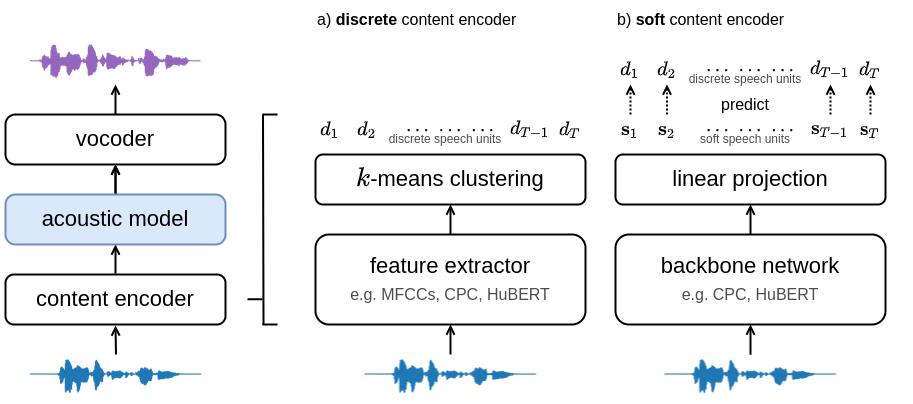Training and inference scripts for the acoustic models in A Comparison of Discrete and Soft Speech Units for Improved Voice Conversion. For more details see soft-vc. Audio samples can be found here. Colab demo can be found here.
import torch
import numpy as np
# Load checkpoint (either hubert_soft or hubert_discrete)
acoustic = torch.hub.load("bshall/acoustic-model:main", "hubert_soft").cuda()
# Load speech units
units = torch.from_numpy(np.load("path/to/units"))
# Generate mel-spectrogram
mel = acoustic.generate(units)usage: generate.py [-h] {soft,discrete} in-dir out-dir
Generate spectrograms from input speech units (discrete or soft).
positional arguments:
{soft,discrete} available models (HuBERT-Soft or HuBERT-Discrete)
in-dir path to the dataset directory.
out-dir path to the output directory.
optional arguments:
-h, --help show this help message and exit
Download and extract the LJSpeech dataset. The training script expects the following tree structure for the dataset directory:
└───wavs
├───dev
│ ├───LJ001-0001.wav
│ ├───...
│ └───LJ050-0278.wav
└───train
├───LJ002-0332.wav
├───...
└───LJ047-0007.wav
The train and dev directories should contain the training and validation splits respectively. The splits used for the paper can be found here.
Extract mel-spectrograms using the mel.py script:
usage: mels.py [-h] in-dir out-dir
Extract mel-spectrograms for an audio dataset.
positional arguments:
in-dir path to the dataset directory.
out-dir path to the output directory.
optional arguments:
-h, --help show this help message and exit
for example:
python mel.py path/to/LJSpeech-1.1/wavs path/to/LJSpeech-1.1/mels
At this point the directory tree should look like:
├───mels
│ ├───...
└───wavs
├───...
Use the HuBERT-Soft or HuBERT-Discrete content encoders to extract speech units. First clone the content encoder repo and then run encode.py (see the repo for details):
usage: encode.py [-h] [--extension EXTENSION] {soft,discrete} in-dir out-dir
Encode an audio dataset.
positional arguments:
{soft,discrete} available models (HuBERT-Soft or HuBERT-Discrete)
in-dir path to the dataset directory.
out-dir path to the output directory.
optional arguments:
-h, --help show this help message and exit
--extension EXTENSION
extension of the audio files (defaults to .flac).
for example:
python encode.py soft path/to/LJSpeech-1.1/wavs path/to/LJSpeech-1.1/soft --extension .wav
At this point the directory tree should look like:
├───mels
│ ├───...
├───soft/discrete
│ ├───...
└───wavs
├───...
usage: train.py [-h] [--resume RESUME] [--discrete] dataset-dir checkpoint-dir
Train the acoustic model.
positional arguments:
dataset-dir path to the data directory.
checkpoint-dir path to the checkpoint directory.
optional arguments:
-h, --help show this help message and exit
--resume RESUME path to the checkpoint to resume from.
--discrete Use discrete units.
If you found this work helpful please consider citing our paper:
@inproceedings{
soft-vc-2022,
author={van Niekerk, Benjamin and Carbonneau, Marc-André and Zaïdi, Julian and Baas, Matthew and Seuté, Hugo and Kamper, Herman},
booktitle={ICASSP},
title={A Comparison of Discrete and Soft Speech Units for Improved Voice Conversion},
year={2022}
}
1- target
The purpose of this project is to eliminate noise on the spectrum
2-Describe innovation
Table 2: Comparison of loss scores for model variations Model Variation L1 (Train) L1 (Validation) Guided Attention (Validation) M1 Standard attention, CE loss 0.0288 0.0611 27.5 × 10−4 M2 M1 + guided attention 0.0249 0.0484 3.99 × 10−4 M3 M2 + local char encodings 0.0245 0.0485 4.19 × 10−4 M4 M1 + positional encodings 0.0230 0.0490 8.42 × 10−4 M5 M4 without CE loss 0.0235 0.0490 17 × 10−4 cially in a language like English where the same characters are spoken many different ways this is not trivial. We observe a simple visualization of the learned character embeddings L in Fig. 3 with some interesting behavior from the model. We could potentially analyze further by examining the output encodings produced by TextEnc, and seeing how these change for words like ”car” and ”cat”. Figure 3: Visualization of implicitly-learned character embeddings. Characters tend to cluster based on their semantics, as well as those with similar sound. We notice an interesting separation of characters with non-vocalized sounds (percussive sounds like ”sh” ”th” etc. that don’t engage our voice) 5 Conclusion and Future Work In conclusion, an interesting learning from this project has been an appreciation of the sheer power and flexibility of deep learning models to learn alignments, character-phoneme relationships, char- acter embeddings, and an audio language model simultaneously. While we used a larger amount of cloud compute credits due to the various experiments we ran - given our training times it is quite possible to build a model with decent prosody, voice and pronunciation in under $75 using our code. We plan to try to extend this model to learning different languages to get a better estimate of the above. It is possible to improve quality by constraining the attention at inference as in [9]. Also, we would like to experiment with two semi-supervised methods for a better initialization of the character embeddings L and weights of AudioEnc and AudioDec. This could be done via Word2Vec-like embeddings for L, and separately training the audio language model (see Section 4.2.1) on audio without labeled transcripts. This could be useful when labeled transcripts might not be as abundant for other languages. Finally, we are also interested in extending this general idea of ’symbols-to- sound’ to a more general problem of generating audio stylistically from a sequence of token inputs (this could be MIDI inputs for music or similar).
3- change surce code import torch, torchaudio import requests import IPython.display as display
